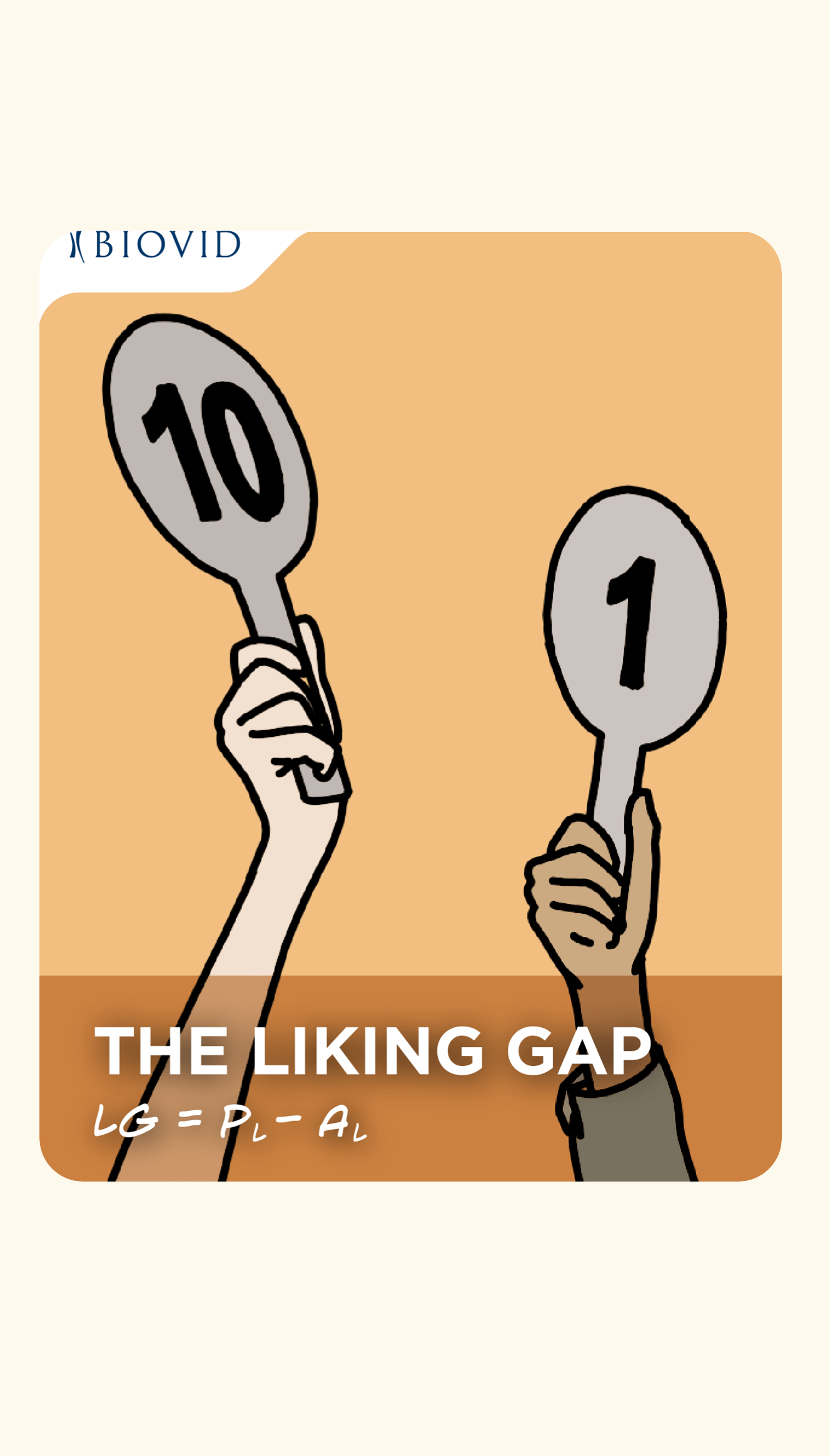People Like You
More Than You Think
Another Way to Alleviate Social Anxiety

HAVE YOU EVER...
Thinking over and over in the conversation just now, worriedly:
“Did I complain too much?”
“Was I being too argumentative?”
“Was my interruption rude?”
“Do they even like me at all...”
Having a conversation with strangers relaxedly rarely seems so easy.
Liking Gaps Exist.

Liking gap is an illusion:
“People systematically underestimated how much their conversation partners liked them and enjoyed their company.”
No matter a chat lasts 5 or 40 minutes, people still underestimate the partner’s positive impressions on the conversation (Boothby et al. 2018, 9). Surprisingly, longer chats don’t tend to close this gap.
Teenagers and young adults feel this gap intensely. Our eager for approval amplify fears of judgment with an unknown outcome (“Do they think I’m awkward?”). But with time, gaps get smaller due to clearer self-awareness.
Anxiety Spiral

Before a Conversation
We can't help but feel that we'll embarass ourselves.
Our brains always suspect new social interactions to be threats: Will they like me? What if I say something stupid? When the partners are strangers, this uncertainty is amplified because brains have no “data” to predict their reactions. So, out of biological instincts, we subconsciously make worst-case assumptions as a default: the upcoming conversation should end in failure (Kenny et al. 1993, 1).
During the Conversation
We are too busy self-monitoring.
We are too focused on criticizing ourselves and preparing the next statements (Keysar & Boaz. 2007, 1). Did I talk too much? What should I say next? Too much attention on perfecting performance turns minor stumbles—a stutter, a forgotten word—into loud alarms belling in mind.
After the Conversation
We ruminate our mistakes and believe that the partner didn't like either this conversation or us.
We immerse ourselves in flashbacks of embarrassing situations(Brozovich et al. 2008, 1). Let's be honest, we've all been there – lying awake replaying "flaws" in mind, noticing those subtle signals indicating the partners' discomfort (maybe 1-pixel drop in their smile corner). Those "evidence" convince us: I left a bad impression! How could I! Regrets and self-blame keep us tossing and turning.
Break
Anxiety Spiral

Before a Conversation
Conversations with strangers are rarely as awkward as we fear. A study shows that participants predicted the upcoming interactions with strangers would be painful—but both sides reported enjoying the conversation far more than expected (Boothby et al. 2018, 9).
So, put your instinctive pessimistic predictions aside! Just relax and trust that others will be attracted to your charms!
We can't help but feel that we'll embarass ourselves.
During the Conversation
Researchers find that conversation partners often send subtle signs of approval: a warm gesture, steady eye contact, or verbal nods like “Exactly!”. But the dynamic nature of dialogue leads to difficulties in achieving cognitive synchronization between two sides, especially when we don't know each other well. So, when we are too concerned about our own performance, these signals fade into the background (Matthew D. et al. 2007, 1).
Plus, another phenomenon, known as “illusion of transparency” (Savitsky et al. 2003, 6), is also adding unease:
“In anxiety-provoking situations, it is often very difficult for people to believe that, despite feeling highly nervous, they do not appear highly nervous.” (Miller et al. 2024)
We naturally assume our inner anxiety is obvious to others. We imagine our shaky voice broadcasts unease or that a flushed cheek screams “I’m bloody nervous!”
In fact, conversations are woven from politeness and people will always hide what they really think (Brown et al. 1987). Plus, years of socialization have already trained us to unconsciously behave friendly. That “panicked” smile? It might look friendly. That awkward "Ummm..."? The brief pause can be read as thoughtful. Studies confirm that observers notice far less of our anxiety than we assume—and surprisingly, simply knowing this improves confidence (Savitsky et al. 2003, 6)!
Try this shift: Instead of self-monitoring, redirect attention outward. Let's keep an eye on partners’ responses: Are they leaning in? Smiling? Asking follow-up questions? These are actual proof we are engaging them.
We are too busy self-monitoring.
After the Conversation
Research shows post-conversation rumination amplifies self-criticism: we judge ourselves against an imaginary “perfect” version, assuming others do the same (Brozovich et al. 2008, 1). But here’s what’s revealing: third-party observers consistently rate our social performance more positively than we do. The gap isn’t in our likability—it’s in our self-perception.
Alone with our feelings, hindsight distorts reality. Revisiting isn’t about expanding anxiety, it’s about trusting that we are more likable than our fears suggest. When next time replaying flashbacks, ask:
“Would I judge someone else this harshly for a stutter or pause?”
“Did partner express interested ever once?”
The partner is likely recalling our ideas or stories, not slip-ups, since they have no incentives to make us perfect. Plus, they’re battling their own liking gap! They also leave conversations thinking, “I hope they didn’t notice my awkwardness.”
We ruminate the mistakes and believe that the partner didn't like either this conversation or us.
Next Step...
Social interactions can feel daunting, but remember: others often see the best in us, even when we are our own harshest critics.
Growth takes time. Be kind to ourselves, celebrate small victories, and trust that connection is always within reach.
Self-Help Guide (NHS inform 2021, 5):
- Make a list of situations we try of escape from.
- Give each a “difficulty score”.
- Keep repeating the least difficult item until the anxiety has reduced.

Need Help? Here Are Resources
If lingering self-doubt or anxiety about connections feels overwhelming, we don’t have to navigate it alone. Reaching out for support is a courageous step toward building confidence and nurturing healthier relationships.
- 24/7 free chat: TheHopeLine.
- Strategies to combat anxiety: ADAA
- Crisis Support: Call or Text 988
Share this article with someone who might need it—you never know who’s struggling in silence.
Quick Reminder: These tips are for encouragement and aren't a substitute for professional help.

Reference
BioVid. “Cognitive Equations Dictionary - BioVid,” January 7, 2025. https://biovid.com/cognitive-equations-dictionary/.
Boothby, Erica J., Gus Cooney, Gillian M. Sandstrom, and Margaret S. Clark. “The Liking Gap in Conversations: Do People Like Us More Than We Think?” Psychological Science 29, no. 11 (September 5, 2018): 1742–56. https://doi.org/10.1177/0956797618783714.
Dibdin, Emma. “6 Podcasts to Soothe an Anxious Mind.” The New York Times, April 27, 2024. https://www.nytimes.com/2024/04/27/arts/podcasts-anxiety-mental-health.html.
Kenny, David A., and Bella M. DePaulo. “Do People Know How Others View Them? An Empirical and Theoretical Account.” Psychological Bulletin 114, no. 1 (January 1, 1993): 145–61. https://doi.org/10.1037/0033-2909.114.1.145.
Keysar, Boaz. “Communication and Miscommunication: The Role of Egocentric Processes.” Intercultural Pragmatics 4, no. 1 (January 20, 2007). https://doi.org/10.1515/ip.2007.004.
Brozovich, Faith, and Richard G. Heimberg. “An Analysis of Post-event Processing in Social Anxiety Disorder.” Clinical Psychology Review 28, no. 6 (January 28, 2008): 891–903. https://doi.org/10.1016/j.cpr.2008.01.002.
Newman, Kira M. “Unwinding Your Anxiety Habit Loop.” Mindful, February 28, 2024. https://www.mindful.org/unwinding-your-anxiety-habit-loop/.
Matthew D. Lieberman and Robert Rosenthal, “Why Introverts Can’t Always Tell Who Likes Them: Multitasking and Nonverbal Decoding.,” Journal of Personality and Social Psychology 80, no. 2 (January 1, 2001): 294–310, https://doi.org/10.1037/0022-3514.80.2.294.
Brown, Penelope, and Stephen C Levinson. 1987. Politeness: Some Universals in Language Usage. Cambridge: Cambridge University Press.
Savitsky, Kenneth, and Thomas Gilovich. “The Illusion of Transparency and the Alleviation of Speech Anxiety.” Journal of Experimental Social Psychology 39, no. 6 (June 30, 2003): 618–25. https://doi.org/10.1016/s0022-1031(03)00056-8.
Miller, Dale T., and Cathy McFarland. “When Social Comparison Goes Awry: The Case of Pluralistic Ignorance.” In Routledge eBooks, 287–313, 2024. https://doi.org/10.4324/9781003469490-14.
NHS inform. “Social Anxiety Self-help Guide | NHS Inform,” May 27, 2021. https://www.nhsinform.scot/illnesses-and-conditions/mental-health/mental-health-self-help-guides/social-anxiety-self-help-guide/.
AI Acknowlege
I use AI (ChatGPT, Gemini, DeepSeek) for this work and there is no copy from AI. AI usage includes:
1. Brainstorm ideas.
2. Ask for instructions on how to use Tableau and write formulas for calculated fields.
3. Generate an image on page2 "Have you ever..." (prompt: a minimalist drawing of two stick figures talking, laughing).
4. Ask for word-usage advice (tell me the differences, explaining with examples, between: due to/owing to/thanks to/because of).
